Experiment and Research on Cutting Mechanical Properties of Little Cabbage
Abstract
:1. Introduction
2. Materials and Methods
2.1. Materials
2.2. Experiment Test Equipment
2.3. Evaluation Index of Experiment
2.4. Influencing Factors of Experiment
2.5. Design of Single Factor and RSM Test
3. Results
3.1. Cutting Force Displacement Curve
3.2. Results of Signal Factor Test
3.3. Results of Response Surface Method Test
3.4. Regression Model Optimization
3.5. Validation Test
4. Discussion
5. Conclusions
Author Contributions
Funding
Institutional Review Board Statement
Informed Consent Statement
Data Availability Statement
Conflicts of Interest
References
- Wójtowicz, T.; Grabowska-Joachimiak, A.; Zieliński, A. Analysis of morpho-anatomical stem properties determining its mechanical strength in selected rye cultivars. Int. Agrophys. 2020, 1, 123–131. [Google Scholar] [CrossRef]
- Du, Z.; Hu, Y.G.; Buttar, N.A. Analysis of mechanical properties for tea stem using grey relational analysis coupled with multiple linear regression. Sci. Hortic. 2020, 260, 108886. [Google Scholar] [CrossRef]
- Meng, Y.; Wei, J.D.; Wei, J.; Chen, H.; Cui, Y.S. An ANSYS/LS-DYNA simulation and experimental study of circular saw blade cutting system of mulberry cutting machine. Comput. Electron. Agric. 2019, 157, 38–48. [Google Scholar] [CrossRef]
- Qiu, M.M.; Meng, Y.M.; Li, Y.Z.; Shen, X.B. Sugarcane stem cut quality investigated by finite element simulation and experiment. Biosyst. Eng. 2021, 206, 135–149. [Google Scholar] [CrossRef]
- Guo, J.; Fu, H.; Yang, Z.; Li, J.; Jiang, Y.L.; Jiang, T.T.; Liu, E.X.; Duan, J.L. Research on the Physical Characteristic Parameters of Banana Bunches for the Design and Development of Postharvesting Machinery and Equipment. Agriculture 2021, 11, 362. [Google Scholar] [CrossRef]
- Zhao, J.L.; Wang, X.G.; Zhuang, J.; Liu, H.L.; Wang, Y.J.; Yu, Y.J. Coupled Bionic Design Based on Primnoa Mouthpart to Improve the Performance of a Straw Returning Machine. Agriculture 2021, 11, 775. [Google Scholar] [CrossRef]
- Chen, P.W.; Sui, J.B.; Wang, C.Y. Cutting Force Analysis of Bovine Acetabular Cartilage. Procedia CIRP 2020, 89, 189–193. [Google Scholar] [CrossRef]
- Zhao, J.L.; Huang, D.Y.; Jia, H.L.; Zhuang, J.; Guo, M.Z. Analysis and experiment on cutting performances of high-stubble maize stalks. Int. J. Agric. Biol. Eng. 2017, 10, 40–52. [Google Scholar] [CrossRef]
- Vu, V.D.; Nguyen, T.T.; Chu, N.H.; Ngo, Q.H.; Ho, K.T.; Nguyen, V.D. Multiresponse Optimization of Cutting Force and Cutting Power in Chopping Agricultural Residues Using Grey-Based Taguchi Method. Agriculture 2020, 10, 51. [Google Scholar] [CrossRef] [Green Version]
- Gan, H.; Mathanker, S.; Momin, M.A.; Kuhns, B.; Stoffel, N.; Hansen, A.; Grift, T. Effects of three cutting blade designs on energy consumption during mowing-conditioning of Miscanthus Giganteus. Biomass Bioenergy 2017, 109, 166–171. [Google Scholar] [CrossRef]
- Zhang, C.; Chen, L.Q.; Xia, J.F.; Zhang, J.M. Effects of blade sliding cutting angle and stem level on cutting energy of rice stems. Int. J. Agric. Biol. Eng. 2019, 12, 75–81. [Google Scholar] [CrossRef]
- Boyda, M.G.; Omakli, M.; Sayinci, B.; KARA, M. Effects of moisture content, internode region, and oblique angle on the mechanical properties of sainfoin stem. Turk. J. Agric. For. 2019, 43, 254–263. [Google Scholar] [CrossRef] [Green Version]
- Wang, Y.; Yang, Y.; Zhao, H.M.; Liu, B.; Ma, J.T.; He, Y.; Zhang, Y.T.; Xu, H.B. Effects of cutting parameters on cutting of citrus fruit stems. Biosyst. Eng. 2020, 193, 1–11. [Google Scholar] [CrossRef]
- Cui, Y.; Wang, W.Q.; Wang, M.H.; Ma, Y.D.; Fu, L.S. Effects of cutter parameters on shearing stress for lettuce harvesting using a specially developed fixture. Int. J. Agric. Biol. Eng. 2021, 14, 152–158. [Google Scholar] [CrossRef]
- Zhang, Y.Q.; Cui, Q.L.; Guo, Y.M.; Li, H.B. Experiment and analysis of cutting mechanical properties of millet stem. T Chin. Soc. Agric. Mach. 2019, 50, 146–155. [Google Scholar] [CrossRef]
- Jiang, P.; Li, Y.P.; Li, J.L.; Meng, H.W.; Peng, X.B.; Zhang, B.C.; He, J.X.; Kan, Z. Experimental research on the bending and fracture characteristics of cotton stalk. Trans. ASABE 2021, 64, 1771–1779. [Google Scholar] [CrossRef]
- Kim, M.S.; Duizer, L.M.; Grygorczyk, A. Application of a Texture Analyzer friction rig to evaluate complex texture attributes in apples. Postharvest Biol. Technol. 2021, 186, 111820. [Google Scholar] [CrossRef]
- Molnár, K.; Virág, A.D.; Halász, M. Shear and yarn pull-out grip for testing flexible sheets by universal load machines. Polym. Test. 2020, 82, 106345. [Google Scholar] [CrossRef]
- Jeong, H.; Choi, S.; Lee, S.; Jeon, S. Rock Cutting Simulation of Point Attack Picks Using the Smooth Particle Hydrodynamics Technique and the Cumulative Damage Model. Appl. Sci. 2020, 10, 5314. [Google Scholar] [CrossRef]
- Vu, V.D.; Ngo, Q.H.; Nguyen, T.T.; Nguyen, H.C.; Nguyen, Q.T.; Nguyen, V.D. Multi-objective optimization of cutting force and cutting power in chopping agricultural residues. Biosyst. Eng. 2020, 191, 107–115. [Google Scholar] [CrossRef]
- Li, C.H.; Hsu, Y.T.; Hsieh, C.H.; Cheng, C.W. A Novel Semiautomatic Flesh Peeling and Seed Removing Mechanism for Dried Longan. Agriculture 2021, 11, 48. [Google Scholar] [CrossRef]
- Jiang, Q.J.; Wang, Y.W.; Chen, J.; Wang, J.; Wei, Z.B.; He, Z.L. Optimizing the working performance of a pollination machine for hybrid rice. Comput. Electron. Agric. 2021, 187, 106282. [Google Scholar] [CrossRef]
- Kornecki, T.S.; Kichler, C.M. Effectiveness of Cover Crop Termination Methods on No-Till Cantaloupe. Agriculture 2021, 12, 66. [Google Scholar] [CrossRef]
- Perotti, F.; Annoni, M.; Calcante, A.; Monno, M.; Mussi, V.; Oberti, R. Experimental Study of Abrasive Waterjet Cutting for Managing Residues in No-Tillage Techniques. Agriculture 2021, 11, 392. [Google Scholar] [CrossRef]
- Jiang, Q.J.; He, Z.L.; Wang, Y.W.; Wang, J. Optimizing the working performance of a boat-type tractor using central composite rotatable design and response surface method. Comput. Electron. Agric. 2021, 181, 105944. [Google Scholar] [CrossRef]
- Zhang, G.S.; Zhang, A.Q.; Xiao, M.H.; Bartos, P.; Bohata, A. Soil-cutting simulation and parameter optimization of rotary blade’s three-axis resistances by response surface method. Comput. Electron. Agric. 2019, 164, 104902. [Google Scholar] [CrossRef]
- Duong, M.T.; Perriard, Y.; Chun, Y.D. Force Reduction in a Short-Stroke Vibration Tubular Generator for Vehicle Energy Harvesting Application. Appl. Sci. 2020, 10, 5847. [Google Scholar] [CrossRef]
- Kang, F.; Tong, S.Y.; Zhang, H.S.; Li, W.B.; Chen, Z.J.; Zheng, Y.J. Analysis and experiments of reciprocating cutting parameters for apple tree branches. Trans. Chin. Soc. Agric. Eng. 2020, 36, 9–16. [Google Scholar] [CrossRef]
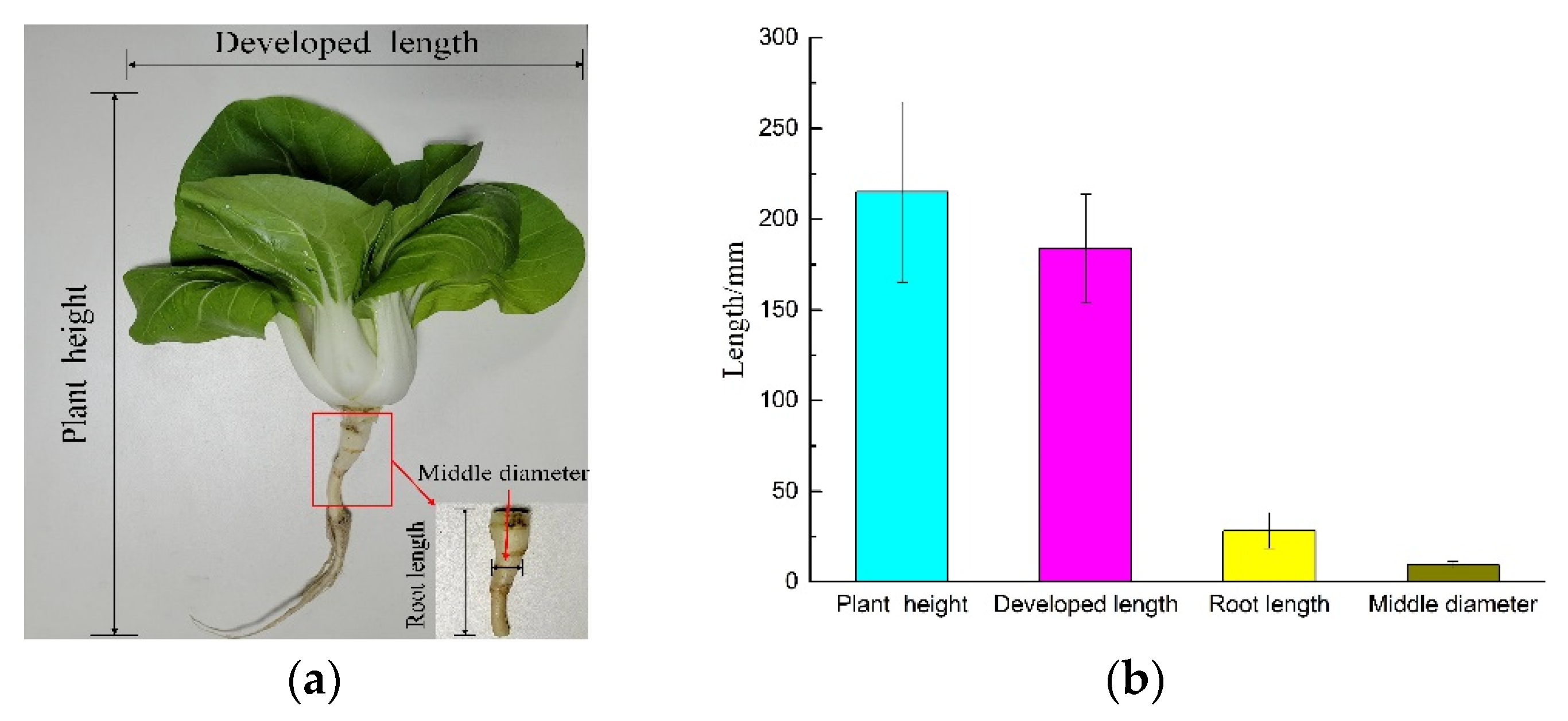


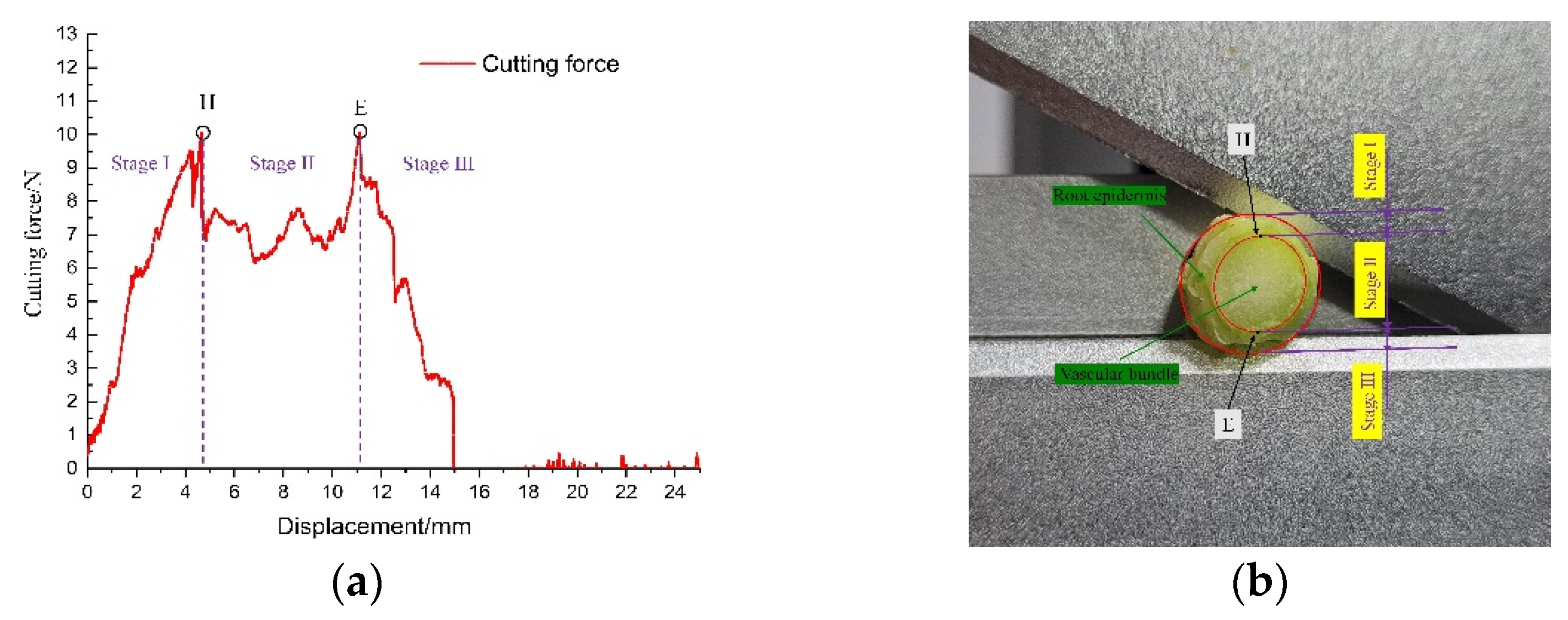
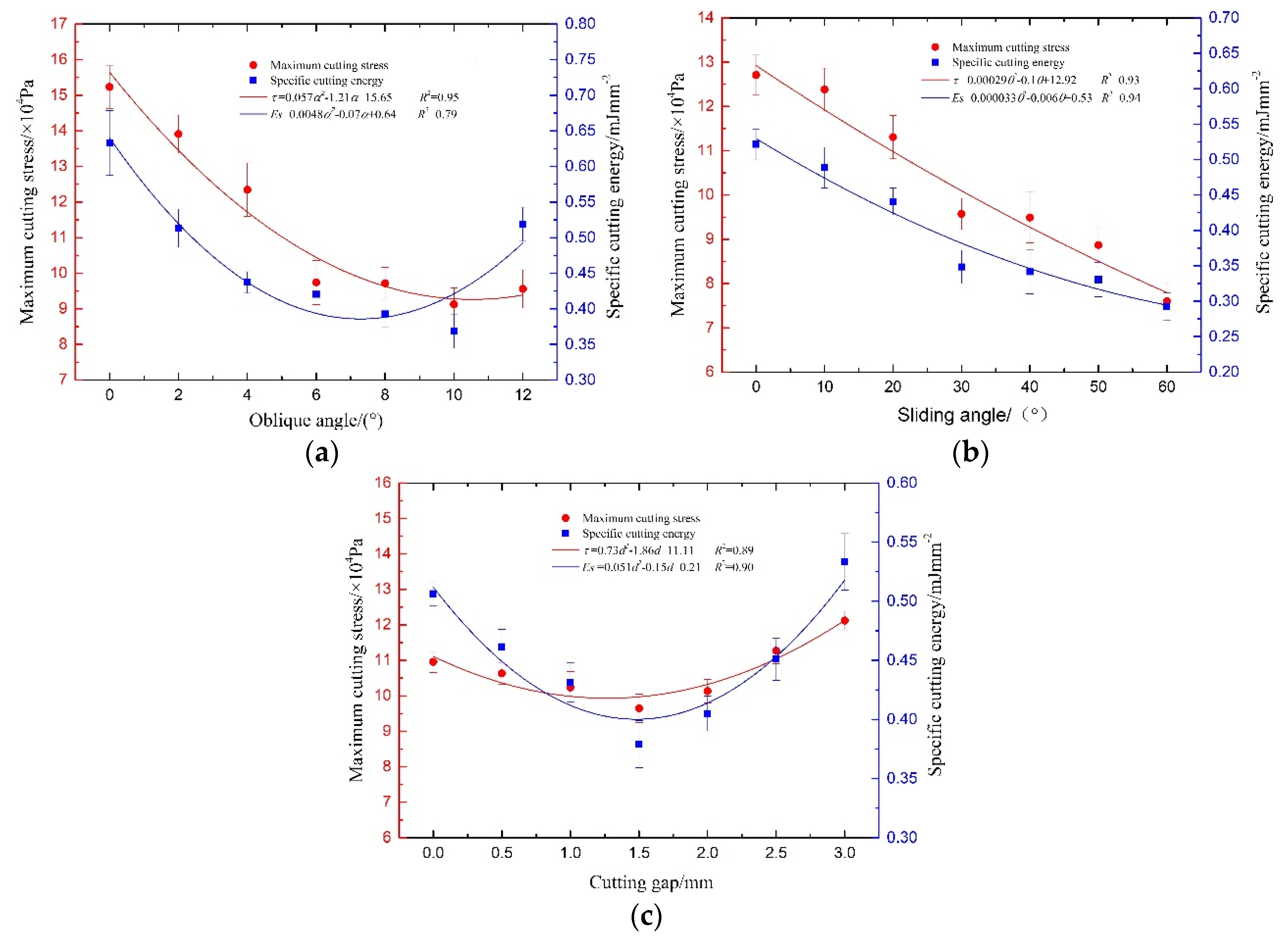
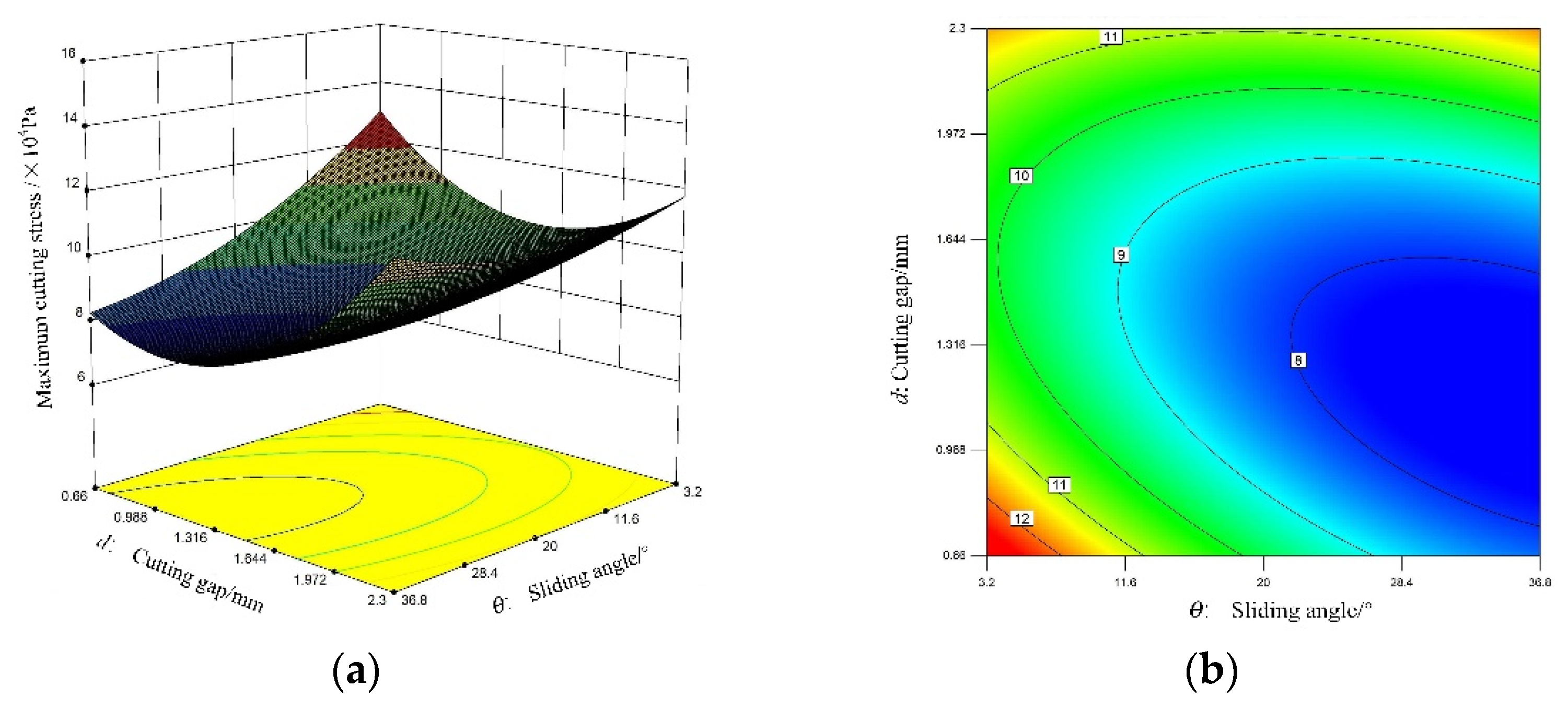
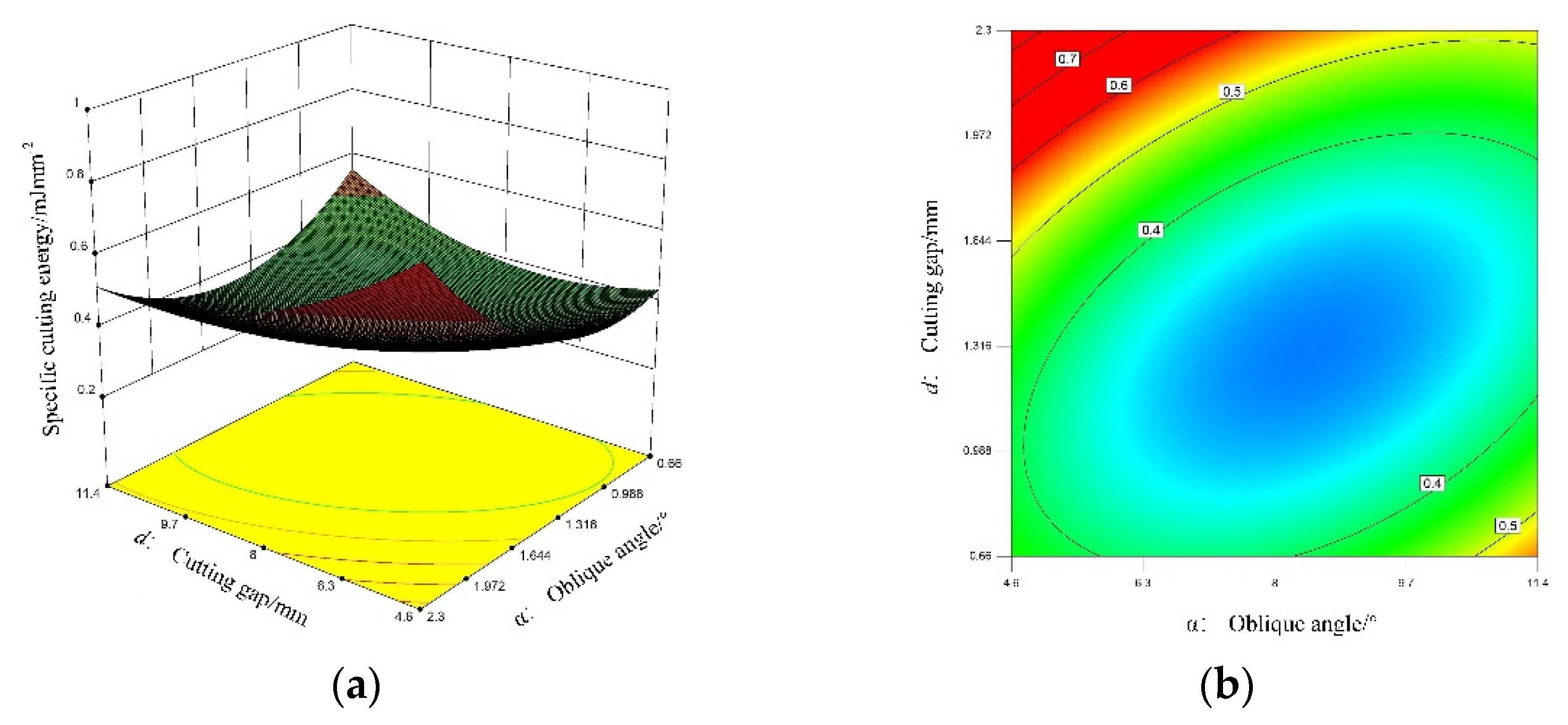

| Level | Factors | ||
|---|---|---|---|
| α/(°) | θ/(°) | d/mm | |
| 1 | 0 | 0 | 0 |
| 2 | 2 | 10 | 0.5 |
| 3 | 4 | 20 | 1 |
| 4 | 6 | 30 | 1.5 |
| 5 | 8 | 40 | 2 |
| 6 | 10 | 50 | 2.5 |
| 7 | 12 | 60 | 3 |
| Level | Factors | ||
|---|---|---|---|
| α/(°) | θ/(°) | d/mm | |
| −1.682 | 4.6 | 3.2 | 0.66 |
| −1 | 6 | 10 | 1 |
| 0 | 8 | 20 | 1.5 |
| 1 | 10 | 30 | 2 |
| 1.682 | 11.4 | 36.8 | 2.3 |
| Test Number | Test Factors | Test Indexes | |||
|---|---|---|---|---|---|
| α (°) | θ (°) | d mm | τ × 104 Pa | Es mJ mm−2 | |
| 1 | 1.000 | 1.000 | −1.000 | 7.80 | 0.29 |
| 2 | 0.000 | 0.000 | 0.000 | 8.21 | 0.30 |
| 3 | 1.682 | 0.000 | 0.000 | 8.39 | 0.39 |
| 4 | 1.000 | −1.000 | 1.000 | 10.53 | 0.42 |
| 5 | 1.000 | −1.000 | −1.000 | 9.15 | 0.41 |
| 6 | 0.000 | −1.682 | 0.000 | 9.63 | 0.40 |
| 7 | 0.000 | 0.000 | 0.000 | 8.48 | 0.35 |
| 8 | 0.000 | 0.000 | 0.000 | 7.95 | 0.34 |
| 9 | −1.682 | 0.000 | 0.000 | 10.9 | 0.47 |
| 10 | 1.000 | 1.000 | 1.000 | 9.89 | 0.39 |
| 11 | −1.000 | −1.000 | 1.000 | 11.52 | 0.57 |
| 12 | 0.000 | 0.000 | 0.000 | 7.79 | 0.33 |
| 13 | 0.000 | 0.000 | 0.000 | 8.60 | 0.33 |
| 14 | −1.000 | 1.000 | 1.000 | 10.69 | 0.54 |
| 15 | −1.000 | 1.000 | −1.000 | 8.87 | 0.37 |
| 16 | −1.000 | −1.000 | −1.000 | 12.58 | 0.32 |
| 17 | 0.000 | 0.000 | 0.000 | 8.39 | 0.26 |
| 18 | 0.000 | 1.682 | 0.000 | 7.99 | 0.29 |
| 19 | 0.000 | 0.000 | −1.682 | 9.89 | 0.42 |
| 20 | 0.000 | 0.000 | 1.682 | 10.84 | 0.60 |
| Source | τ | Es | ||||||||
|---|---|---|---|---|---|---|---|---|---|---|
| Sum of Squares | Freedom | Mean Square | F-Value | p-Value | Sum of Squares | Freedom | Mean Square | F-Value | p-Value | |
| Model | 34.67 | 9 | 3.85 | 17.00 | <0.0001 | 0.16 | 9 | 0.017 | 14.07 | 0.0001 |
| α | 8.09 | 1 | 8.09 | 35.71 | 0.0001 | 0.013 | 1 | 0.013 | 10.12 | 0.0098 |
| θ | 6.32 | 1 | 6.32 | 27.88 | 0.0004 | 0.007 | 1 | 0.007 | 6.22 | 0.0318 |
| d | 2.49 | 1 | 2.49 | 10.98 | 0.0078 | 0.050 | 1 | 0.050 | 39.87 | <0.0001 |
| αθ | 0.81 | 1 | 0.81 | 3.59 | 0.0875 | 0.004 | 1 | 0.004 | 3.26 | 0.1012 |
| αd | 0.92 | 1 | 0.92 | 4.05 | 0.0718 | 0.013 | 1 | 0.013 | 10.30 | 0.0094 |
| θd | 1.61 | 1 | 1.61 | 7.11 | 0.0236 | 0.00005 | 1 | 0.00005 | 0.040 | 0.8451 |
| α2 | 5.03 | 1 | 5.03 | 22.19 | 0.0008 | 0.018 | 1 | 0.018 | 14.41 | 0.0035 |
| θ2 | 1.26 | 1 | 1.26 | 5.55 | 0.0403 | 0.00039 | 1 | 0.00039 | 0.31 | 0.5874 |
| d2 | 10.29 | 1 | 10.29 | 45.43 | <0.0001 | 0.058 | 1 | 0.058 | 46.81 | <0.0001 |
| Residual | 2.27 | 10 | 0.23 | 0.012 | 10 | 0.00124 | ||||
| Lack-of-fit | 1.77 | 5 | 0.35 | 3.56 | 0.0950 | 0.00139 | 5 | 0.00139 | 1.27 | 0.4007 |
| Error | 0.50 | 5 | 0.099 | 0.00109 | 5 | 0.00109 | ||||
| Total | 36.93 | 19 | 0.17 | 19 | ||||||
| Items | Maximum Cutting Stress /×104 Pa | Specific Cutting Energy /mJ mm−2 |
|---|---|---|
| Test value | 6.92 | 0.25 |
| Predicted value | 7.43 | 0.28 |
| Relative errors/% | 6.9 | 10.8 |
Publisher’s Note: MDPI stays neutral with regard to jurisdictional claims in published maps and institutional affiliations. |
© 2022 by the authors. Licensee MDPI, Basel, Switzerland. This article is an open access article distributed under the terms and conditions of the Creative Commons Attribution (CC BY) license (https://creativecommons.org/licenses/by/4.0/).
Share and Cite
Wang, W.; Wang, S.; Zhang, J.; Lv, X.; Yi, Z. Experiment and Research on Cutting Mechanical Properties of Little Cabbage. Appl. Sci. 2022, 12, 2060. https://doi.org/10.3390/app12042060
Wang W, Wang S, Zhang J, Lv X, Yi Z. Experiment and Research on Cutting Mechanical Properties of Little Cabbage. Applied Sciences. 2022; 12(4):2060. https://doi.org/10.3390/app12042060
Chicago/Turabian StyleWang, Wei, Shilin Wang, Jinqi Zhang, Xiaolan Lv, and Zhongyi Yi. 2022. "Experiment and Research on Cutting Mechanical Properties of Little Cabbage" Applied Sciences 12, no. 4: 2060. https://doi.org/10.3390/app12042060
APA StyleWang, W., Wang, S., Zhang, J., Lv, X., & Yi, Z. (2022). Experiment and Research on Cutting Mechanical Properties of Little Cabbage. Applied Sciences, 12(4), 2060. https://doi.org/10.3390/app12042060





